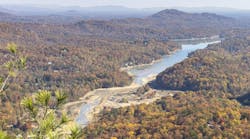
Last month, the Third US Circuit Court of Appeals issued a ruling upholding the Chesapeake Bay Total Maximum Daily Load (TMDL). The ruling in American Farm Bureau Federation v. EPA essentially said that EPA does have the authority under the Clean Water Act to develop a detailed TMDL, including allocating wasteloads and timelines for compliance.
Last month, the Third US Circuit Court of Appeals issued a ruling upholding the Chesapeake Bay Total Maximum Daily Load (TMDL). The ruling in American Farm Bureau Federation v. EPA essentially said that EPA does have the authority under the Clean Water Act to develop a detailed TMDL, including allocating wasteloads and timelines for compliance. [text_ad] The Chesapeake Bay TMDL was adopted in 2010, and although EPA has roughly 40,000 TMDLs throughout the US, this one is by far the largest and most complex. Developing it required negotiations with all the states in the Chesapeake Bay watershed—Maryland and Virginia on the bay’s shoreline, as well as West Virginia, Pennsylvania, and Delaware—plus the District of Columbia. The goal is to achieve significant reductions in nitrogen, phosphorus, and sediment entering the bay. Widespread pollution had caused algae blooms and dead zones, depletion of underwater grasses, and harm to aquatic and shoreline habitats, which in turn affected recreation, tourism, and the fishing and shellfishing industries. An article in the July/August issue of Stormwater magazine examines the development of the TMDL, the role of the states, and the progress to date. EPA is monitoring the progress of individual districts and states to ensure milestones are met, and water quality is slowly improving. Even air quality regulations have helped, as reduction in atmospheric nitrogen from smokestacks and other sources has reduced nitrogen input to the bay. Stormwater—from both urban and agricultural areas—continues to be a serious problem, however. The goal is to fully restore the bay by 2025, with at least 60% of the necessary actions and practices to do so in place by 2017.The Chesapeake Bay TMDL was adopted in 2010, and although EPA has roughly 40,000 TMDLs throughout the US, this one is by far the largest and most complex. Developing it required negotiations with all the states in the Chesapeake Bay watershed—Maryland and Virginia on the bay’s shoreline, as well as West Virginia, Pennsylvania, and Delaware—plus the District of Columbia. The goal is to achieve significant reductions in nitrogen, phosphorus, and sediment entering the bay. Widespread pollution had caused algae blooms and dead zones, depletion of underwater grasses, and harm to aquatic and shoreline habitats, which in turn affected recreation, tourism, and the fishing and shellfishing industries.
An article in the July/August issue of Stormwater magazine examines the development of the TMDL, the role of the states, and the progress to date. EPA is monitoring the progress of individual districts and states to ensure milestones are met, and water quality is slowly improving. Even air quality regulations have helped, as reduction in atmospheric nitrogen from smokestacks and other sources has reduced nitrogen input to the bay. Stormwater—from both urban and agricultural areas—continues to be a serious problem, however. The goal is to fully restore the bay by 2025, with at least 60% of the necessary actions and practices to do so in place by 2017.About the Author
Janice Kaspersen
Janice Kaspersen is the former editor of Erosion Control and Stormwater magazines.


